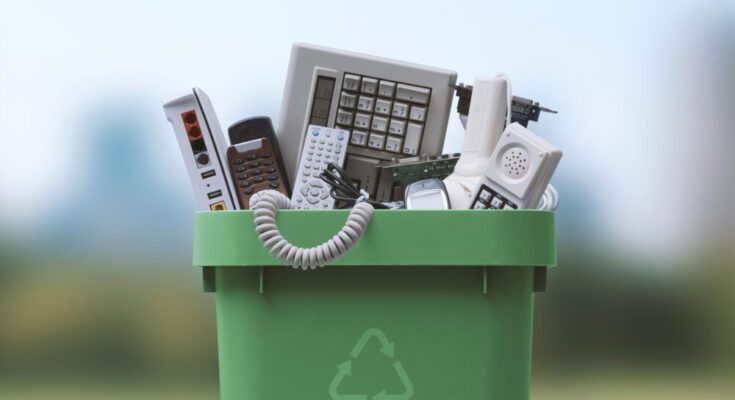E trash recycling represents one of the most urgent environmental challenges facing Singapore today, yet it remains largely invisible to most residents who discard outdated devices without understanding the toxic legacy they leave behind. Every year, Singaporeans generate approximately 60,000 tonnes of electronic waste, equivalent to each person throwing away 70 mobile phones. This consumption pattern cannot continue without severe consequences for the environment, public health, and Singapore’s limited resources.
The Hidden Toxicity in Your Discarded Electronics
Electronic devices contain hazardous substances including lead in circuit boards, mercury in flat screens, cadmium in batteries, and brominated flame retardants in plastic casings. As one former United Nations Environment Programme official notes, “E-waste is a silent kind of waste unlike plastic waste, which is in your face.” This invisibility makes the problem easier to ignore.
When electronic waste burns, it releases toxic fumes that increase the risk of respiratory illnesses. Harmful metals and chemicals seep into soil and pollute waterways. Heavy metals contaminate incineration ash that ends up in Singapore’s only landfill at Pulau Semakau, which faces capacity limits by 2035.
Understanding Singapore’s E-Waste Problem
The statistics paint a troubling picture. Currently, only 6 per cent of the electronic waste generated in Singapore gets recycled. Another 26 per cent ends up thrown away with general household waste, mixed in with food scraps and other rubbish. A quarter gets traded in or sold, whilst 35 per cent of bulky items like washing machines and refrigerators get carted away by delivery workers when new appliances arrive. The fate of much of this material remains uncertain, often ending up with informal collectors who lack proper facilities.
Research reveals that 60 per cent of Singapore residents do not know or remain unsure of how to recycle their electronic waste. This knowledge gap creates a vicious cycle where well-intentioned people inadvertently contribute to the problem. Even among those who do attempt recycling, mistakes happen frequently. Only one in ten young Singaporeans recycle electronic waste, and amongst those who try, three in ten place items in the wrong bins.
The scale of consumption continues to grow. Rising affluence, embedded consumerism, and products deliberately designed with limited lifespans create an accelerating disposal rate:
- Mobile phones replaced every two years or less
- Laptops deemed obsolete when newer models launch
- Kitchen appliances discarded when repairs cost more than replacements
- Gaming consoles abandoned for the latest generation
- Smart home devices that become incompatible with newer systems
This pattern of planned obsolescence ensures that manufacturers profit from perpetual consumption whilst communities bear the environmental and health costs.

The Extended Producer Responsibility Framework
Singapore enacted groundbreaking legislation in 2019 through the Resource Sustainability Act, establishing an Extended Producer Responsibility framework that shifts accountability to manufacturers. Under this system, producers of electrical and electronic goods must finance the collection and proper recycling of their products.
As Ron Wong, Director of the Waste Management Division at the National Environmental Agency, explains, “It’s important for us to shift from a linear economy to a circular one.” Electronic trash recycling presents enormous opportunity in this transition because discarded devices contain valuable materials: copper, gold, silver, rare earth elements, and other metals.
Retailers with outlets larger than 300 square metres must now establish collection points and offer free collection of old electronics when delivering new purchases. Over 600 electronic waste collection bins now exist across Singapore, making proper disposal more convenient.
What Proper Recycling Actually Achieves
Electronic waste recycling offers benefits beyond clearing landfill space. Recovering materials from discarded electronics reduces environmentally destructive mining operations. Manufacturing new phones from recycled components uses significantly less energy than extracting and processing raw materials.
The economic value proves substantial. Globally, at least 62.5 billion dollars worth of electronic waste gets discarded annually, representing more than twice Cambodia’s entire GDP. Singapore’s electronic refuse contains recoverable resources if properly processed.
Proper electronic waste management prevents toxic substances from contaminating air, water, and soil. Communities near informal recycling operations often experience elevated rates of respiratory problems and developmental issues in children. Professional facilities protect both workers and surrounding populations.
Individual Actions That Create Collective Change
Understanding electronic trash recycling matters little without corresponding action. Start by holding onto devices longer. Does your mobile phone truly need replacing because a newer model exists, or does it still function adequately for your needs? Repair rather than replace when possible. Many issues that seem terminal prove fixable at reasonable cost.
When disposal becomes necessary, take responsibility for doing it properly. Locate the nearest collection bin using the National Environmental Agency’s online map. Utilise retailer take-back programmes when purchasing replacements. Never place electronic items in regular waste bins where they will end up incinerated or landfilled.
Support right-to-repair legislation and companies that design products for longevity rather than obsolescence. Voice concerns to manufacturers about planned obsolescence and demand better product lifespans. Your purchasing decisions send signals that influence corporate behaviour.
The Future We Choose
The path forward requires both systemic change and individual responsibility. Singapore’s regulatory framework establishes necessary infrastructure, but effectiveness depends on participation. Every person who properly disposes of their electronic devices contributes to resource conservation, pollution prevention, and a more sustainable future.
The alternative grows increasingly untenable. Pulau Semakau fills steadily whilst extraction of virgin materials accelerates environmental degradation globally. Health costs from improper electronic waste handling continue accumulating in communities least able to bear them. We possess the knowledge, systems, and technology to address this crisis. What remains is commitment to actually using them. The transformation from linear consumption to circular resource flows depends on millions of individual choices, including yours, about something as seemingly mundane as proper e trash recycling.




